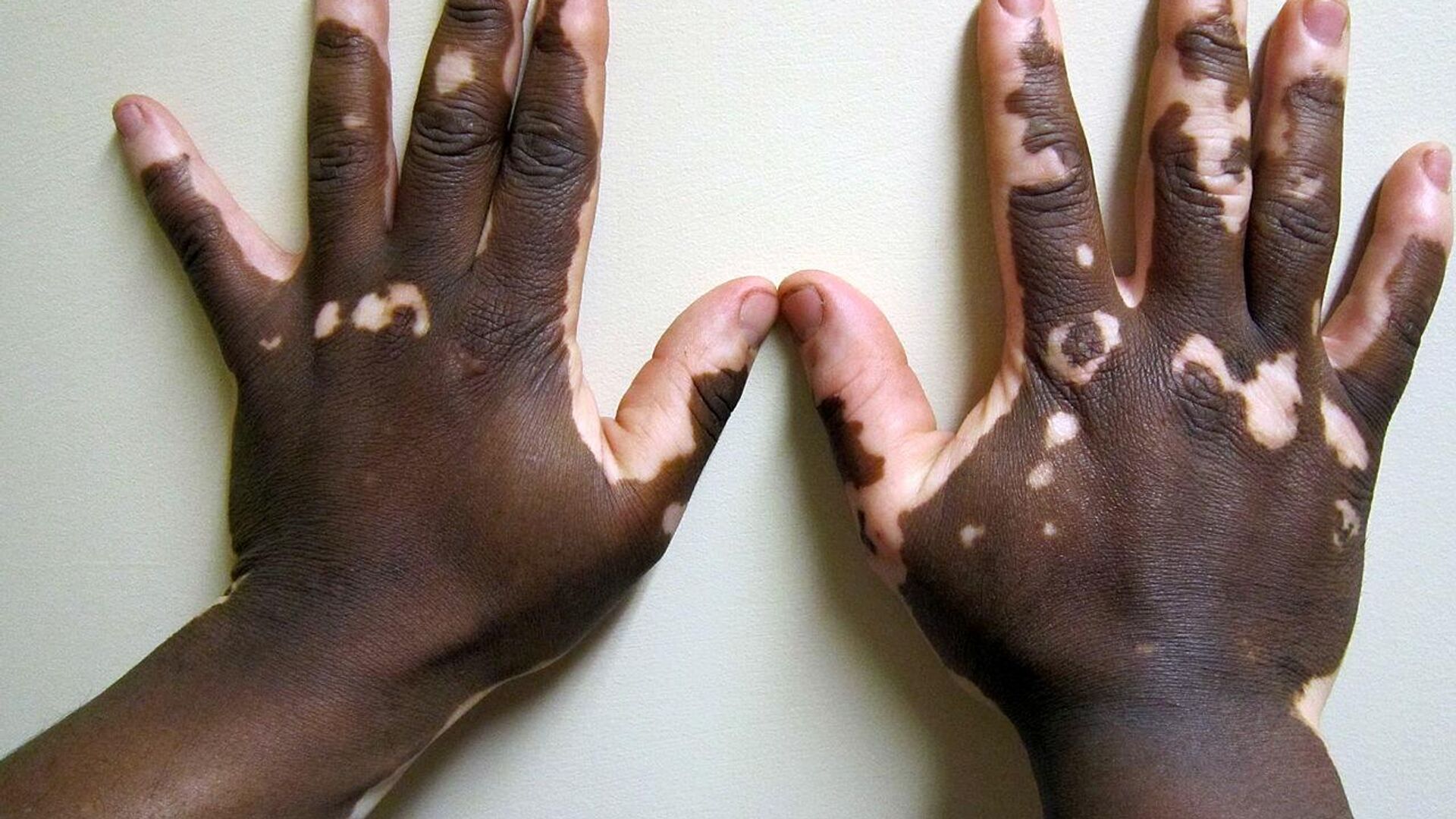https://sputniknews.in/20230117/doctors-throw-light-on-vitiligo-disease-after-indian-actress-diagnosed-with-skin-disorder-523298.html
Doctors Throw Light on Vitiligo Disease After Indian Actress Diagnosed With Skin Disorder
Doctors Throw Light on Vitiligo Disease After Indian Actress Diagnosed With Skin Disorder
Sputnik India
One percent of the world's people have the depigmentation skin disorder. India records the highest rates with about 8 to 9% of the total population suffering. 17.01.2023, Sputnik India
2023-01-17T19:26+0530
2023-01-17T19:26+0530
2023-01-19T15:09+0530
india
health
https://cdn1.img.sputniknews.in/img/07e7/01/11/538978_0:94:1281:814_1920x0_80_0_0_beb8856347b432d871923fe1560da873.jpg
Indian actress Mamta Mohandas is losing the color of her skin due to vitiligo auto-immune disease. The diagnosis comes after she successfully battled Hodgkin's Lymphoma cancer previously.On Monday, Mamta posted a picture of her basking in the sun and opened up about her skin disorder on social media. Sputnik spoke to Indian dermatologists about what vitiligo disease is and what the ways to prevent it are.What is Vitiligo Disease? Dr. Monica Chahar, chief dermatologist and director of Skin Decor in Delhi, told Sputnik News that vitiligo is a chronic depigmentation disorder which causes loss of skin color and white patches all over the skin. "It causes the skin cells to stop forming pigmentation and also affects the immune system. The condition is not life-threatening or contagious," Dr. Chahar explained. "Exposure to chemicals at a factory or in beauty products, like hair dye, can trigger vitiligo," Dr. Singh said. A person of any age group can reportedly be affected: "People who are under 20 years of age have 50 percent chances of getting vitiligo, while those between 30–40 years of age, there are 70-80 percent chances of manifestation of the disease," he said.Signs & Symptoms Dr. Jaishree Sharad, cosmetic dermatologist and founder of Skinfinitii Aesthetic Skin and Laser Clinic in Mumbai, tells Sputnik that the early signs of Vitiligo could be rashes on the face or hands and white spots appearing.While Vitiligo is clinically diagnosed, doctors do a skin biopsy and a couple of tests to screen for thyroid, diabetes, rheumatoid arthritis and other autoimmune diseases. Treatment & Cure Since Vitiligo is a chronic disease, Dr. Chahar explained that it might take months and years to get the skin pigmentation back, but there are high chances of its reoccurrence later on. "After diagnosis, patients are advised to protect the skin from sun tanning and apply sunscreen while stepping out. One must also avoid food that has citric acid in it and this is when you have vitiligo. If a doctor asks you to take sunlight for a few minutes. There are certain medicines that work in tandem with the sunlight," Dr. Sharad says.To prevent the spread of the disease, doctors prescribe steroids, tablets, and lotions, and then they use phototherapy in which ultra-violet lights are used to trigger repigmentation in the cells. Some also perform excimer laser tests to treat the white patch on the skin. Preventive Measures Doctors advise people having a family history of vitiligo disease to take precautionary measures to prevent themselves from getting it. Since it is an autoimmune disease, Dr. Singh advised that one should also take multi-vitamins and antioxidant food and apply sun protection while stepping out. "Patients should avoid taking any kind of stress or pressure and stay away from skin cuts and burns as it also triggers the condition and can make it difficult to heal fast," Dr. Singh concluded.
india
Sputnik India
feedback.hindi@sputniknews.com
+74956456601
MIA „Rossiya Segodnya“
2023
Sangeeta Yadav
https://cdn1.img.sputniknews.in/img/07e6/0c/0f/110602_0:0:641:640_100x100_80_0_0_c298016a79eb02ef8caa9d1f688c12a5.jpg
Sangeeta Yadav
https://cdn1.img.sputniknews.in/img/07e6/0c/0f/110602_0:0:641:640_100x100_80_0_0_c298016a79eb02ef8caa9d1f688c12a5.jpg
News
en_IN
Sputnik India
feedback.hindi@sputniknews.com
+74956456601
MIA „Rossiya Segodnya“
Sputnik India
feedback.hindi@sputniknews.com
+74956456601
MIA „Rossiya Segodnya“
Sangeeta Yadav
https://cdn1.img.sputniknews.in/img/07e6/0c/0f/110602_0:0:641:640_100x100_80_0_0_c298016a79eb02ef8caa9d1f688c12a5.jpg
what is vitiligo disease, indian actress' diagnosed with vitiligo skin disease, chronic skin disease, precaution, preventive measure, treatment, cure
what is vitiligo disease, indian actress' diagnosed with vitiligo skin disease, chronic skin disease, precaution, preventive measure, treatment, cure
Doctors Throw Light on Vitiligo Disease After Indian Actress Diagnosed With Skin Disorder
19:26 17.01.2023 (Updated: 15:09 19.01.2023) One percent of the world's people have the depigmentation skin disorder. India records the highest rates with about 8 to 9% of the total population suffering.
Indian actress Mamta Mohandas is losing the color of her skin due to vitiligo auto-immune disease. The diagnosis comes after she successfully battled Hodgkin's Lymphoma cancer previously.
On Monday, Mamta posted a picture of her basking in the sun and opened up about her skin disorder on social media.
Sputnik spoke to Indian dermatologists about what vitiligo disease is and what the ways to prevent it are.
What is Vitiligo Disease?
Dr. Monica Chahar, chief dermatologist and director of Skin Decor in Delhi, told Sputnik News that vitiligo is a chronic depigmentation disorder which causes loss of skin color and white patches all over the skin.
"It causes the skin cells to stop forming pigmentation and also affects the immune system. The condition is not life-threatening or contagious," Dr. Chahar explained.
Dr. Ramanjit Singh, senior consultant dermatologist at Medanta Hospital in Gurugram, explained to Sputnik that vitiligo can occur either genetically or be triggered by oxidative stress and anxiety or cuts and burns on the skin.
"Exposure to chemicals at a factory or in beauty products, like hair dye, can trigger vitiligo," Dr. Singh said.
A person of any age group can reportedly be affected: "People who are under 20 years of age have 50 percent chances of getting vitiligo, while those between 30–40 years of age, there are 70-80 percent chances of manifestation of the disease," he said.
Dr. Jaishree Sharad, cosmetic dermatologist and founder of Skinfinitii Aesthetic Skin and Laser Clinic in Mumbai, tells Sputnik that the early signs of Vitiligo could be rashes on the face or hands and white spots appearing.
"It appears from light colored spots on the skin which progress to completely white colored spots and patches. Many spots can merge together and become confluent large spots as well, and they can occur in any part of the body, from the head to toe including lips, hair, and eyebrows," Dr. Sharad shares.
While Vitiligo is clinically diagnosed, doctors do a skin biopsy and a couple of tests to screen for thyroid, diabetes, rheumatoid arthritis and other autoimmune diseases.
Since Vitiligo is a chronic disease, Dr. Chahar explained that it might take months and years to get the skin pigmentation back, but there are high chances of its reoccurrence later on.
"After diagnosis, patients are advised to protect the skin from sun tanning and apply sunscreen while stepping out. One must also avoid food that has citric acid in it and this is when you have vitiligo. If a doctor asks you to take sunlight for a few minutes. There are certain medicines that work in tandem with the sunlight," Dr. Sharad says.
To prevent the spread of the disease, doctors prescribe steroids, tablets, and lotions, and then they use phototherapy in which ultra-violet lights are used to trigger repigmentation in the cells.
Some also perform excimer laser tests to treat the white patch on the skin.
"Once the white pigmentation stops spreading, one may opt for melanocyte transplant or grafting of the skin on the affected areas," Dr. Sharad said.
Doctors advise people having a family history of vitiligo disease to take precautionary measures to prevent themselves from getting it.
"If one identifies spots and suspected patches on the body, the first and most important thing is to get it checked by a dermatologist as early as possible. If the doctor confirms, then one should avoid triggers that can aggregate the condition. These triggers could be certain chemicals in hair dyes, scratching the skin," Dr. Chahar says.
Since it is an autoimmune disease, Dr. Singh advised that one should also take multi-vitamins and antioxidant food and apply sun protection while stepping out.
"Patients should avoid taking any kind of stress or pressure and stay away from skin cuts and burns as it also triggers the condition and can make it difficult to heal fast," Dr. Singh concluded.


